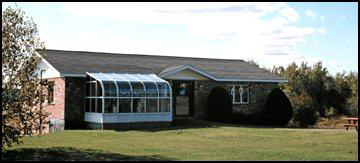- Category: Demographics
- Published on 28 March 2006
- Hits: 15813
Town of Oxbow |
|
|
Oxbow: The Aroostook River runs through the town of Oxbow; it is a beautiful country that can be described as serene and grand. Along the banks are large tracts of timberland, and land that had been cleared proved to be excellent fertile land for planting. Forest in the 1800’s could be seen as far as the eye could see. During the fall season, this area was and is still picturesque with its valleys, rivers, streams and mountains. Oxbow Plantation was the farthest inhabited area in Aroostook County. After crossing Houlton Brook and Trout Brook and coming to the town line, the land, with its meadows, was used for farming. After leaving the agricultural area, it was difficult to imagine a person could travel through the forest and reach the Canadian settlements at the St. Lawrence River. When looking west along the road at the foot of the slope, the Umcolcus Lake can be seen in the southwest corner of No. 8, Range 5, and the lake flows northwesterly across the corner of Penobscot County and enters Oxbow Plantation. There it flows into the Aroostook River; a half-mile to the right is the Aroostook River and making the “Oxbow”. This is how Oxbow got its name. According to the dictionary, Oxbow is “the U-shaped part of an ox yoke, which passes under and around the animal’s neck.” It’s from the windings to an oxbow that the plantation got it's name. At this moment, there are some popular camps in Oxbow that have the same name, Umcolcus Sporting Camps. To the north are the Machias Mountains and to the southwest is the Katahdin. The Mooseleuk Mountains are also located in this area. During the 1800’s, winter was the busiest time of the year because of the lumbering that had to be done. The Aroostook War was one of the reasons Oxbow became known as a fertile region. Many who marched with the posse to fight the British stayed in Oxbow. Much of the wilderness was made into farms, and homes were built there as well. Elias H & Samuel Hayden came to Oxbow to check out the land. They came from Madison Center, Somerset County in September 1839. They traveled by way of Patten to Masardis and went by boat to Presque Isle. After a short time in Presque Isle, they went up the river to Oxbow. With the assistance of surveyor, Henry Cunningham, they selected their lots on the south side of the river. The Haydens returned again the next summer and started clearing land. They were the first settlers to stay in the area. Samuel Hayden moved with his family in 1842 into their farm house and stayed until 1860. His lot proved to be excellent farm land. Elias Hayden, who was still unmarried at the time, built a log camp. He was the first to have a framed building, also known as a barn, in Oxbow. He purchased his lumber from Pollard’s Mill at St. Croix. They came down by stream to Masardis; then, he poled them to the Oxbow. The next year, Elias married the daughter of Thomas Goss. A frame house was built in 1849 to replace the log camp. This was the year he also built a hotel. John Winslow was the next settler to come to Oxbow in 1842. Before moving there, he had lived in Freedom. He settled close to Mr. Hayden. He became the first clerk of Oxbow. He also farmed and lumbered. Thomas Goss, Jr. came to Oxbow in 1842. He settled in the western part of Oxbow; he stayed there for a short time before moving to Masardis. In 1870, he returned to Oxbow and lived there until his death. Also in the same year, Isaac Junkins and six men came to build a mill and dam. Mr. Junkins came from Lincoln. In 1848, he moved his family to Oxbow. In 1843, Aaron Scribner and his family moved to the Umcolcus Stream and stayed there for twenty-five years. Ira Fish & Co., which was located in Patten, built a saw mill on the Umcolcus Stream in 1843. In turn for building the mill, the state gave his company land. In 1852, Shepard Boody purchased both the mill and the land. He transported lumber by water and teams for years to Bangor because the price was much higher in Bangor. The other owners of the mill were George Sawyer and C.C. Libby. Other early settlers in Oxbow at this time were: William Bottin, Abram Currier, Samuel Willard, James Anderson, Thomas Fleming and John McLean. Even though the early settlers came in 1839, the town was not organized as No. 9, Range 6 until 1848. In 1870, it became Oxbow Plantation. This is a poem by Susan Sherman, which sums up Oxbow. Little Oxbow “Oxbow is a little town The Old Schoolhouse Back from the road the schoolhouse sits, The yard where once the children played, The open door where Teacher stood The well worn sagging door sill Inside a few old desks, As I wander down through the weedy yard, By Grace Weeks After the Oxbow Historical Society was formed, much of it's history has been preserved. All students are now bused to the Ashland school system. Oxbow is now under SAD #32. |
|


 Central Aroostook Chamber of Commerce
Central Aroostook Chamber of Commerce Oxbow
Oxbow